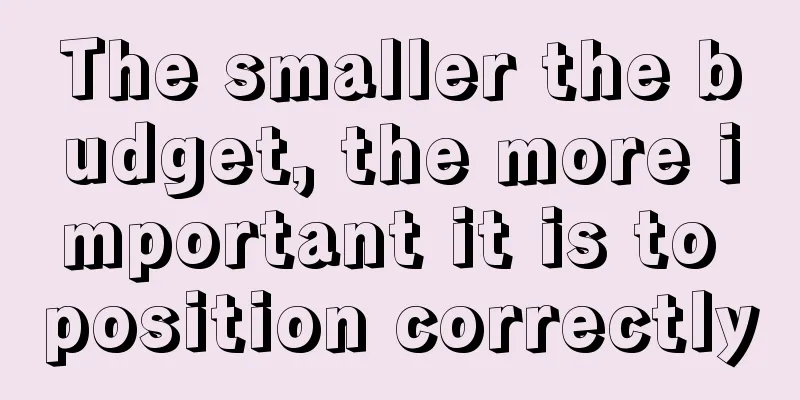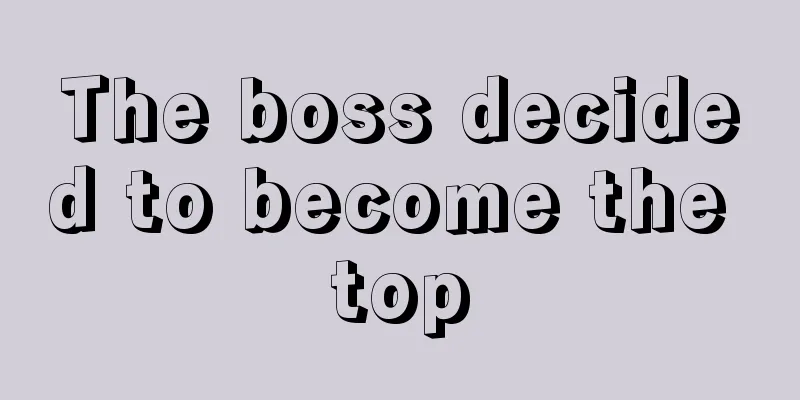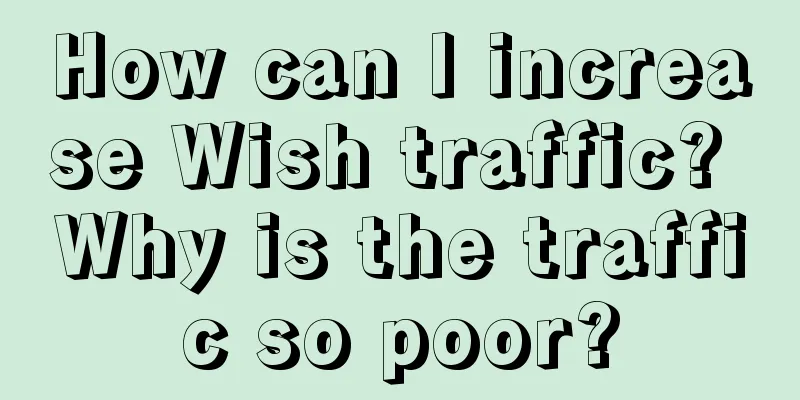The smaller the budget, the more important it is to position correctly

The key to creating a brand is correct positioning, and the key to correct positioning is to discover, occupy and expand a word. Brands guided by the "positioning theory" need to spend a lot of money on advertising. Is it only suitable for large enterprises? Small and medium-sized enterprises cannot afford "positioning"? Some people even say that companies without a 100 million advertising budget do not need to do "positioning". This is of course a misunderstanding, and a cognitive misunderstanding. Because only brands with large-scale communication can know its existence, and incidentally know the existence of "positioning". Therefore, the perception that "positioning cannot be achieved without large-scale communication" is generated. This is a cognitive fact that we must certainly acknowledge. However, you can also do a good job of "positioning" without extensive publicity. The key is to accurately position and find vacancies. In fact, the smaller the budget of a small or medium-sized enterprise, the more it needs to do positioning. Because only by doing a good job of positioning can a small or medium-sized enterprise grow into a large enterprise. Take regional soy sauce brands as an example: It is not only large companies that can create brands, nor is it only through large amounts of advertising that brands can be built. Small and medium-sized enterprises can also create brands, and they can beat big brands in the region. Doesn't it seem a bit exaggerated? A small business with an annual turnover of one million can also beat a business with an annual turnover of tens of billions or even hundreds of billions. This is the power of correct positioning. Taking the soy sauce brand in the county as an example, it needs to face competition from the city-level soy sauce brands, as well as national brands such as Chubang, Haitian, and Weidam. Soy sauce brands in county towns can position themselves as follows: only selling 60-day fresh, additive-free soy sauce. If big brands want to expand nationwide, they will inevitably extend the shelf life to one year. This is an inherent weakness that national brands cannot overcome. In theory, small brands in other categories can also use this strategy. In fact, the book "Positioning" mentioned the example of Long Island Bank, which is also an example that regional brand "positioning" does not need a large-scale publicity . Many people's so-called doubts about "positioning" are really just caused by not reading seriously. Continuing with this regional soy sauce brand, it will have to keep moving forward and not occupy and expand this "positioning" through large-scale communication. The most critical core rule is to focus , focus on the original population , original region , original channel , original market and core big products (that is, hot-selling products), and establish your own base. Take Wanglaoji as an example. Before it entered the general public through mass advertising, it had been quietly developing in the hot pot channel and Sichuan and Hunan cuisine channels in the southwest region, deliberately avoiding the attention of Coca-Cola. Not only did it not have mass advertising, but it was also very low-key. This is the stage of discovering and occupying a "position". When he wanted to promote the word "herbal tea", he started to spread it widely. At that time, the hot sales in the catering channel were enough to support his promotion expenses. This is the stage of occupying and expanding a "positioning". Of course, the specific approach is not that simple. Here we just want to clarify a fact: it is possible to do a good job of "positioning" without large-scale publicity. At this point, some people may think: Is it true that as long as we find a segmented scenario, we have found our own "positioning"? Not really. Cognitive advantage (which is the effect that "positioning" wants to achieve) is more important than the scene . Cognitive advantage is the explosive, and scene trigger is the fuse. In the scenario of commuting coffee or office coffee, Nestlé coffee has existed for a long time. Why don’t customers choose Nestlé? Before Luckin Coffee, customers would also bring Starbucks to the office. There are Starbucks in the lobby of many office buildings, so customers can bring Starbucks to the office. There are also many convenience stores near office buildings, such as Convenience Bee and FamilyMart, which have self-service coffee machines. Why don’t customers choose them? Is it just because Luckin can deliver to customers? If it’s because it’s convenient, then wouldn’t it be more convenient for customers to brew Nestle coffee by hand? If it’s because it tastes good, then wouldn’t it also taste good if customers bought Starbucks directly from downstairs? Again, no brand can occupy a scene, just like no brand can occupy a crowd. So it is wrong to think about brands from the scene or crowd. The starting point of a brand is customer perception , because a brand can occupy a position in perception. For example, safety sockets, herbal tea, cola, young cola, natural water, young liquor, safe cars, smart cars, brain-boosting drinks, hot pot, hamburgers, pickled fish, etc. Each of these positions is occupied by a brand. Then they might enter a scene. Luckin Coffee has taken a position of "cheaper than Starbucks and tastier than brewed coffee" through business model innovation. This position can be defined as: cost-effective takeaway coffee. It is not as delicious as Starbucks, but it is cheaper than Starbucks. It is more expensive than brewed coffee, but it tastes better than brewed coffee. In order to prevent customers from thinking that he is inferior to Starbucks, he cognitively associates it with Starbucks, saying that he is cheap because of his innovative model, while Starbucks is expensive because of rent and IQ tax, thereby solving the psychological barriers of customers: others will not think that drinking Luckin means being poor. Customers who want to drink coffee but think Starbucks is too expensive and brewed coffee is not tasty will choose Luckin. Commuting or office scenarios are the choices after Luckin can achieve this. In short, cognitive advantage is more important than customer scenarios. It is the brand that has cognitive advantage that enters a certain scenario, not the brand that achieves success because it chooses a certain scenario. "Cognitive advantage" is the dynamite, and "user scenario" is the fuse. Just lighting the fuse will not detonate a trend, and having only dynamite but not using the right scenario will not work either. In short, the smaller the budget, the more important it is to do "positioning". Only by positioning correctly can you avoid detours and create a brand efficiently. The first step to correct positioning is to occupy a word in the external customer's cognition, and then to create products, choose channels, and expand scenarios. The order of priority cannot be messed up. The idea that “positioning” can only be achieved through extensive communication is a bias that conforms to cognitive laws. Because we can only discuss phenomenal brands, these brands usually spend a lot of money on marketing. For example, the county town soy sauce brand I mentioned earlier is called “Langyatai Soy Sauce”, which is difficult to arouse the interest of most people. But we cannot conclude that only large-scale communication can achieve "positioning". On the contrary, brands with smaller budgets need to have correct positioning in order to grow into big brands. Author: Zhang Zhiyu Source: WeChat public account "Zhang Zhiyu (ID: zhiyu2307)" |
<<: Xiaohongshu search: a must-have for brand marketing in 2024
>>: With Sora's brutal intrusion, how can advertising professionals survive?
Recommend
What is Shopbop? Is it reliable?
Now that everyone's living standards have impr...
In-depth Insight | The Dilemma of Private Domain Traffic
This article will deeply analyze the root causes a...
Who will bear the shipping fee for Shopee's free shipping campaign? How to ship after placing an order on Shopee?
As a leading e-commerce platform in Southeast Asia...
Is being a “nanny” to AI the way out for people like Tianya?
Tianya, a long-established Chinese community, has ...
After Taobao's major adjustments, some merchants rushed to the point where their single products had sold more than 1 million units.
Taobao sales display rules have changed, which is ...
No. 1 in the category in 6 years! How does Pidan make Xiaohongshu placement in the hot pet supplies market?
How can pet product brands make a good brand marke...
To operate the user in a refined manner, it is enough to do these two things well.
What is user-based refined operation? How can we a...
How to add variations on Amazon? How many variations can Amazon have?
On Amazon, the global e-commerce giant’s sales pla...
The rise of white-label products: the new favorite in the market behind the change in consumer attitudes
Starting from the change in the consumption concep...
5 ideas for creating hit products on Xiaohongshu, used by more than 300 million brands!
If you want to create a product that quickly takes...
The price of AI has skyrocketed tenfold, and the toy industry wants to create another Pop Mart
With the continuous advancement of artificial inte...
What is your keyword for 2022?
In a blink of an eye, the balance in 2022 is less ...
Which one is better, Lazada or Shopee? How to operate cross-border e-commerce?
In addition to domestic e-commerce platforms such ...
Among Douyin, Kuaishou, Toutiao, WeChat official accounts, and Xiaohongshu, which one is easier to make money by running your own media?
This article compares and analyzes the advantages ...
What is the most difficult thing about running an e-commerce business?
Online shopping has become a common thing in our l...









